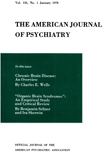Symptom Differences in Schizophrenia with Good and Poor Prognosis
Abstract
The authors studied 28 good prognosis and 25 poor prognosis schizophrenics, differentiated on the basis of duration of illness and premorbid level of functioning. When compared for differences in symptomatology, the good prognosis group was found to be more likely to have diagnosable mania or depression, visual hallucinations, perceptual disorders, and confusion, and was less likely to have affective blunting and a combination of special types of auditory hallucinations and haptic hallucinations. Like previous reports, which have established that good prognosis schizophrenia is closely related to the affective disorders by family history, this study demonstrated a close clinical relationship between good prognosis schizophrenia and the affective disorders.
Access content
To read the fulltext, please use one of the options below to sign in or purchase access.- Personal login
- Institutional Login
- Sign in via OpenAthens
- Register for access
-
Please login/register if you wish to pair your device and check access availability.
Not a subscriber?
PsychiatryOnline subscription options offer access to the DSM-5 library, books, journals, CME, and patient resources. This all-in-one virtual library provides psychiatrists and mental health professionals with key resources for diagnosis, treatment, research, and professional development.
Need more help? PsychiatryOnline Customer Service may be reached by emailing [email protected] or by calling 800-368-5777 (in the U.S.) or 703-907-7322 (outside the U.S.).



